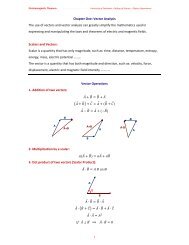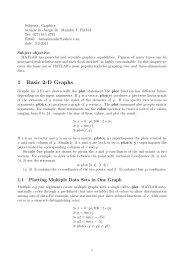Sentence Relations in the Writing of EFL Students at University Level
Sentence Relations in the Writing of EFL Students at University Level
Sentence Relations in the Writing of EFL Students at University Level
Create successful ePaper yourself
Turn your PDF publications into a flip-book with our unique Google optimized e-Paper software.
Table- 6<br />
The Classific<strong>at</strong>ion <strong>of</strong> Incorrect and Correct Use <strong>of</strong> Ellipsis<br />
Incorrect Percentage Correct<br />
<strong>of</strong> Incorrect<br />
Types <strong>of</strong><br />
Ellipsis<br />
Percentage<br />
<strong>of</strong> Correct<br />
Nom<strong>in</strong>al 16 %100 4 %100<br />
Total 16 %100 4 %100<br />
7.1.4 Conjunction<br />
1-Incorrect Use: some <strong>of</strong> <strong>the</strong> students’ compositions show th<strong>at</strong> <strong>the</strong> students<br />
are unable to use <strong>the</strong> correct conjunctive when l<strong>in</strong>k<strong>in</strong>g two sentences, such<br />
as <strong>the</strong> follow<strong>in</strong>g:<br />
9. Gett<strong>in</strong>g to college on time is a problem.<br />
Traffic jam is also ano<strong>the</strong>r problem. We live outside city and<br />
this makes us have problem, if I get before hour and half<br />
before usual time <strong>of</strong> start<strong>in</strong>g lectures I seldom be <strong>the</strong>re. Every<br />
day I try my best to reach <strong>at</strong> college early. Thus I fail.<br />
10.Gett<strong>in</strong>g to college on time is a problem.<br />
When we get up we must take a taxi to go to college .As we<br />
know today we have problem with petrol. However <strong>the</strong> drivers<br />
want too much money. When we ask <strong>the</strong>m to take us.<br />
In (9) <strong>the</strong> fourth sentence expresses a contrast (th<strong>at</strong> <strong>the</strong> student tries<br />
his best to reach <strong>at</strong> college early thus he fails). Therefore, <strong>the</strong> correct<br />
conjunctive th<strong>at</strong> should be used to show this contrast is ‘but’ or<br />
“however”. In (10) <strong>the</strong> third sentence respectively expresses a result (th<strong>at</strong><br />
<strong>the</strong> drivers want too much money) for causes <strong>in</strong>dic<strong>at</strong>ed earlier <strong>in</strong> <strong>the</strong><br />
second and first sentences respectively (th<strong>at</strong> we have problem with petrol).<br />
Therefore, <strong>the</strong> correct conjunctive th<strong>at</strong> should be used to show <strong>the</strong>se<br />
cause/effect successions is “<strong>the</strong>refore” <strong>in</strong>stead <strong>of</strong> “however” The types <strong>of</strong><br />
conjunctions and <strong>the</strong>ir rel<strong>at</strong>ive frequencies <strong>of</strong> errors observed <strong>in</strong> <strong>the</strong><br />
writ<strong>in</strong>g samples are given <strong>in</strong> <strong>the</strong> follow<strong>in</strong>g table:<br />
Table -7-<br />
The Classific<strong>at</strong>ion <strong>of</strong> Incorrect and Correct Use <strong>of</strong> Conjunction<br />
Types <strong>of</strong> Incorrec Percentage <strong>of</strong> Incorrect Correct Percentage<br />
Conjunctions t<br />
<strong>of</strong> Correct<br />
Causal 78 %38.48 25 %45.45<br />
Advers<strong>at</strong>ive 53 %25.85 15 %27.27<br />
Addition 49 %23.90 7 %12.72<br />
Temporal 25 %12.19 8 %14.54<br />
Total 205 %100 55 %100<br />
7.1.5 Lexical cohesion<br />
Lexical cohesion far outstrips reference, substitution, ellipsis and<br />
conjunction and comes to <strong>the</strong> conclusion th<strong>at</strong> <strong>at</strong> least forty percent <strong>of</strong><br />
textual ties are lexical. In fact, lexical ties are impossible to quantify<br />
accur<strong>at</strong>ely, because <strong>the</strong>re is noth<strong>in</strong>g to prevent a lexical item form<strong>in</strong>g a<br />
rel<strong>at</strong>ionship with more than one o<strong>the</strong>r item. Our observ<strong>at</strong>ions <strong>of</strong> students’<br />
@@@@@@@@@@@Journal <strong>of</strong> Zankoy Sulaimani. Part B. No. 29 June 2010@ 220@

















